The machine chest fly is a strength training exercise that works the chest muscles. It is a popular exercise in gyms and fitness centers because it isolates the chest muscles. This means the exercise only works the chest muscles without actively working the triceps or shoulders.
This exercise provides a smooth and controlled movement, resulting in a more focused and intense workout. It is used in strength training and bodybuilding routines to build bigger and stronger chest.
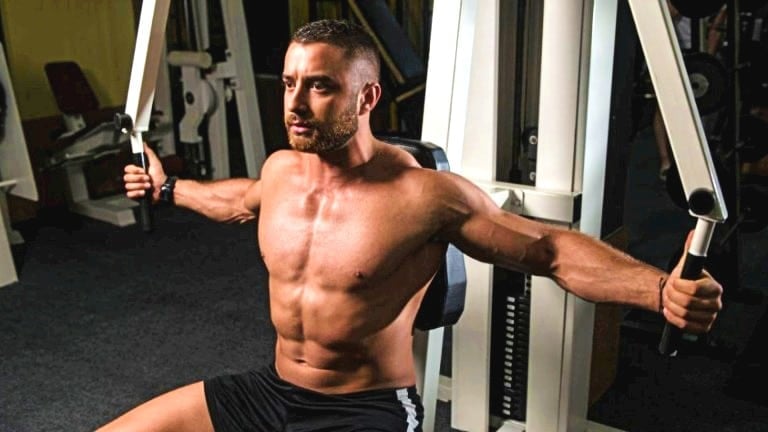
- How Does The Pectoral Fly Machine Work?
- Machine Chest Fly Muscles Worked
- How To Do Machine Chest Fly
- Pec Deck Fly
- How To Do Pec Deck Fly
- Machine Pectoral Fly Form and Tips
- Benefits of the Pec Deck Chest Fly
- FAQs
- Is the fly machine good for the chest?
- Do chest flys build size?
- How many sets and repetitions should I do for the machine chest fly?
- References
How Does The Pectoral Fly Machine Work?
When you push the handles together, the chest muscles are contracted, and the machine’s weight provides resistance. This creates micro-tears in the muscle fibers, which then repair and grow during rest periods, resulting in muscle hypertrophy.
The angle at which you perform the machine pectoral fly can impact the targeted muscles, such as the upper, middle, and lower chest.
- By placing your hands at chest level, you can effectively target all chest muscles equally. (Best One)
- One can effectively target the lower chest muscles by placing their hands below the chest level on the handles.
- Positioning your hands above the chest level on the handles of the Pec Deck machine puts more focus on the upper chest muscles.
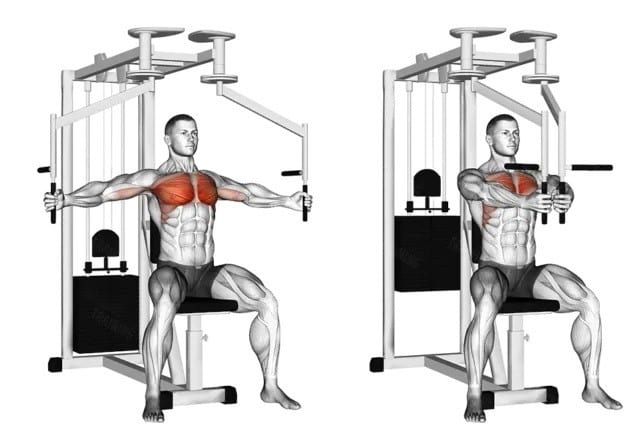
There are two methods of doing it: machine chest fly and pec deck fly. Both focus on the chest, but they have a few differences.
- The machine chest fly is performed using straight elbows. The open position allows for greater stretch. It offers a greater range of motion at the open position than the pec deck.
- The pec deck machine provides a greater range of motion in the closed position of the finished pads. This makes the elbows closer together, which makes the inner chest muscles work harder. Pec decks can be used with heavier loads than chest fly machines.
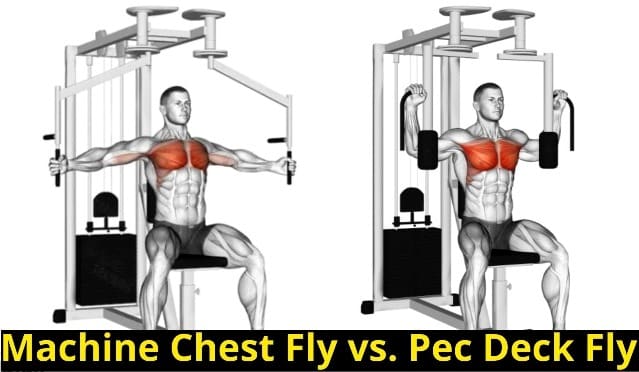
Caution:
When you change your hand position during the machine, the chest fly can affect the range of motion. Please be careful not to exceed your comfortable range, especially if you have any pre-existing shoulder or chest issues.
Want to take your gains to the next level? Discover your daily calorie needs with our free TDEE calculator
Machine Chest Fly Muscles Worked
- The machine chest fly primarily works the pectoralis major muscles, including the upper, Lower, and Inner Chest.
- In addition, the pec deck fly involves several synergist muscles, including the Tricep Brachii and Anterior deltoids.
- A handful of other muscles worked or play the role of stabilizer muscles, including your Biceps Brachii, Levator scapulae, and Wrist flexors.
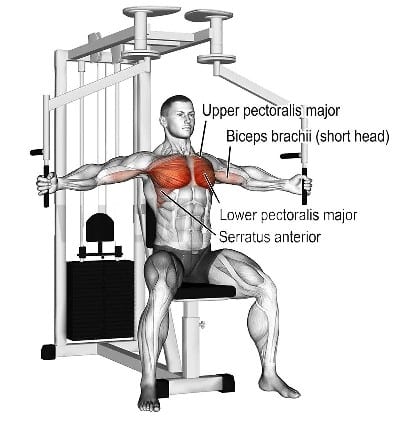
How To Do Machine Chest Fly
- Adjust the seat so that your feet are flat on the floor.
- Ensure that the handles are at chest level or slightly below.
- Seat Position: Sit on the machine with your back firmly against the backrest.
- Grab the vertical handles with elbows slightly bent.
- Keep your chest lifted, shoulders down and back, and core engaged.
- Exhale as you slowly bring the handles together in front of your chest.
- Once the handles are together, pause briefly at the fully contracted position. Squeeze your chest muscles and feel the tension in the target area.
- Inhale and gradually release the handles, allowing your arms to return to the initial position.
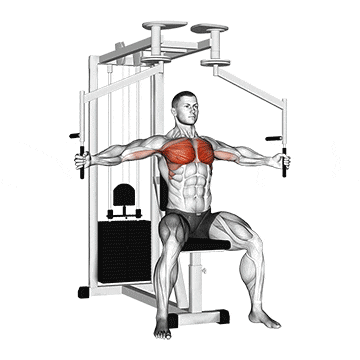
Read More To Know More: Chest Dumbbell Fly: Muscle Worked, Foam, Alternative
Pec Deck Fly
This exercise is performed with a pec deck machine consisting of two padded lever arms or handles you push together in front of your chest.
The pec deck fly is especially effective at targeting the inner chest muscles. The fixed path of motion and the ability to close the handles together allow for a strong contraction.
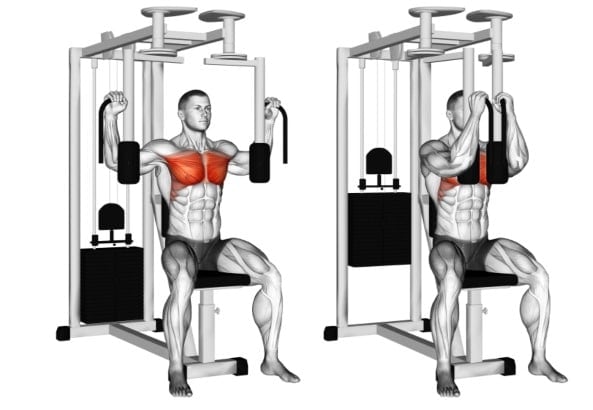
How To Do Pec Deck Fly
- Set the seat height so that the handles are at chest level.
- Sit on the machine with your back against the backrest.
- Position your forearms on the padded lever arms or handles.
- Your arms are parallel to the floor, and your elbows are bent at a 90-degree angle.
- Exhale and push the handles together in front of your chest.
- Pause briefly at the fully contracted position, feeling the tension in the chest muscles.
- Inhale and slowly release the handles back to the starting position.
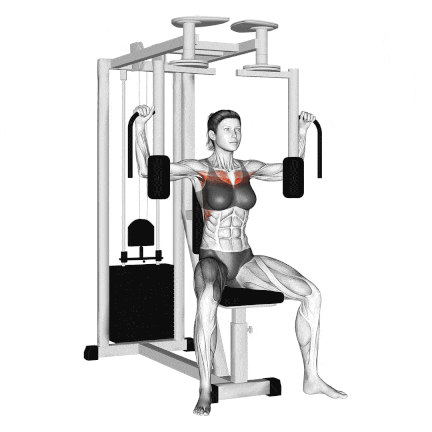
Machine Pectoral Fly Form and Tips
- Keep your back against the backrest. Avoid slouching or arching your back.
- Keep your core engaged by drawing your belly button in towards your spine. This helps you keep your body stable and straight.
- Avoid shrugging your shoulder muscles because this can make it hard for the chest muscles to work properly.
- Focus on a controlled and deliberate movement. Avoid swinging or using momentum to bring the handles together.
- Breathe properly, exhale as you bring the handles together, and inhale as you lower them back down. Keep breathing slowly and steadily.
- Focus on the muscles you are targeting, specifically the chest muscles. Create a mind-muscle connection.
- Pick a weight that you can control, that’s not too light or too heavy — find what’s right for you.
- Your upper arms should be parallel to the floor.
- Keep your eyes straight ahead while performing the exercise.
- Try to bring the handles together so that your hands meet your chest. Squeeze your chest muscles to maximize the engagement.
Benefits of the Pec Deck Chest Fly
- Muscular hypertrophy is one of the primary benefits of the machine fly. When you exercise, your chest muscles work harder, making them stronger and bigger.
- It is an isolation exercise that specifically targets the chest muscles. This is good for people who want to build their chest muscles without using other muscles like the shoulders and triceps.
- The Pec Deck Chest Fly provides a controlled and guided range of motion compared to other chest exercises, such as dumbbell flys.
- The machine’s design allows for a full stretch and contraction of the chest muscles, ensuring optimal muscle activation.
- Compared to barbell bench presses or push-ups, the Pec deck chest fly minimizes joint strain, particularly the shoulder joints. It’s a good choice for people who want to reduce joint stress while still working their chest muscles.
- The fly is great because it’s a nice chest opener that teaches scapular retraction.
FAQs
Is the fly machine good for the chest?
The chest fly machine is a good exercise for new or experienced lifters. It helps them make the right movements and doesn’t use too much of their core muscles, which helps them work their pectoral muscles.
Like all flies, the pec deck fly is a great exercise to add variety to your chest workouts and uniquely challenge the muscles.
Do chest flys build size?
Yes, chest exercises help build chest muscles. When performed properly and with appropriate weight or resistance, chest fly exercises can create micro-tears in the muscle fibers, stimulating muscle growth and hypertrophy.
How many sets and repetitions should I do for the machine chest fly?
Do 3–4 sets of 8–12 reps of machine chest fly. Adjust the weight, reps, and sets to challenge yourself further while still maintaining proper form.
References
- Solstad TE, Andersen V, Shaw M, Hoel EM, Vonheim A, Saeterbakken AH. A Comparison of Muscle Activation between Barbell Bench Press and Dumbbell Flyes in Resistance-Trained Males. J Sports Sci Med. 2020 Nov 19;19(4):645-651. PMID: 33239937; PMCID: PMC7675616.
- Borges, Eduardo & Mezêncio, Bruno & Pinho, João & Soncin, Rafael & Barbosa, João & Araujo, Felipe & Gianola, Fabio & Amadio, Alberto & Serrao, Julio. (2018). Resistance training acute session: pectoralis major, latissimus dorsi and triceps brachii electromyographic activity. Journal of Physical Education and Sport. 18. 10.7752/jpes.2018.02095.
- American Council on Fitness. Three most effective chest exercises.

Manish brings over 10 years of hands-on experience in weight lifting and fat loss to fitness coaching. He specializes in gym-based training and has a lot of knowledge about exercise, lifting technique, biomechanics, and more.
Through “Fit Life Regime,” he generously shares the insights he’s gained over a decade in the field. His goal is to equip others with the knowledge to start their own fitness journey.
